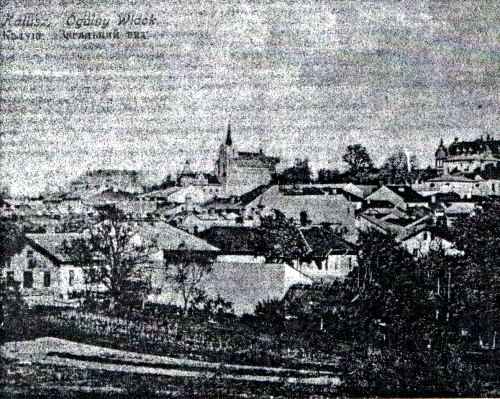 |
|
|
By M. E.
Translated by Deborah Schultz
Already as early as the fifteenth century, they were aware in Poland of the salt mines around Kalush. By the sixteenth century, Jews had already sometimes held the lease of sale of the salt. In 1650, there was already an organized Jewish community [there]. The K”K Kalush [Kehilah Kedoshah Kalush; in Hebrew, the Jewish community of Kalush] was not an ir v'am [Jewish community of great importance]; she was just like the other ordinary towns in Galicia, Lesser-Poland.
The community possessed the Fir Kinyonim [in Yiddish, the “Four Acquisitions” necessary to form a Jewish community according to tradition]: the shul [synagogue], the public bath, the [ritual kosher] slaughterhouse, and the cemetery. The Fir Eigns [in Yiddish, the “Four Possessions”] served the religious need of the Jewish population in Kalush town.
In the thirties, [the Jewish community of] Kalush built itself its own community building. (Earlier, the community had occupied the building, standing near the Ukrainian “Dom Narodny [People's House, or community center]” [off the] Boyfortsele [Beaufort Way?], which the city hall had donated to the Jews of Kalush.) A beautiful, large, ground-floor building whose walls were covered not with simple plaster, but with gleaming mosaic. On the roof went up, through the entire width of the outside wall, a shield, with a large inscription in four-angled letters: “K”K Kalush,” and in the Polish language: “¯ydowski Gmina Wyznaniowa w Ka³uszu [transliterated from Yiddish, meaning the Jewish religious community of Kalush?].”
The building is no more! Gone are the Fir Kinyonim [Four Acquisitions]! Missing are the 6000 Jewish souls! The bones of the martyrs lie scattered over the cursed Polish earth, without graves and without gravestones!
Let this book be an eternal memorial . . .
In the book, we write down to remember well what Jewish Kalush had: the rooted Jewish way of life, the ethical lifestyle, which she instilled in the hearts and minds of her Jewish inhabitants.
We recall her Sabbath Jews and her everyday Jews; her scholars, the religious Jews and the secular Jews; her merchants, craftsmen, workers. We tell of her institutions, organizations, unions, and political parties.
With great sorrow and deep pain, we lament the era of the Umkum [in Yiddish, the Holocaust]: the dreadful and brutal end, which the hands of the despicable, may their names be erased, brought to her.
One should know this and never forget! We leave this as an inheritance for our children and our children's children. And let God, blessed be He, collect the innocent, spilled blood. Amen!
New York, Tammuz 5738 [July/August 1978]
[Page 335]
|
|
|
|
[Page 355]
|
|
|
|
|
|
JewishGen, Inc. makes no representations regarding the accuracy of
the translation. The reader may wish to refer to the original material
for verification.
JewishGen is not responsible for inaccuracies or omissions in the original work and cannot rewrite or edit the text to correct inaccuracies and/or omissions.
Our mission is to produce a translation of the original work and we cannot verify the accuracy of statements or alter facts cited.
 Kalusz, Ukraine
Kalusz, Ukraine
 Yizkor Book Project
Yizkor Book Project
 JewishGen Home Page
JewishGen Home Page
Copyright © 1999-2026 by JewishGen, Inc.
Updated 12 Jul 2020 by MGH